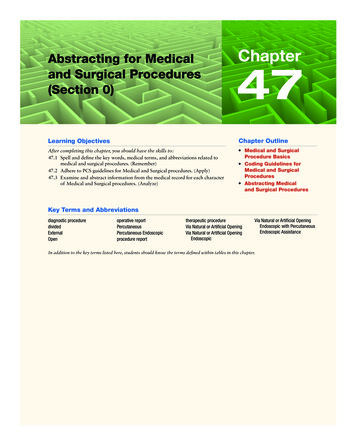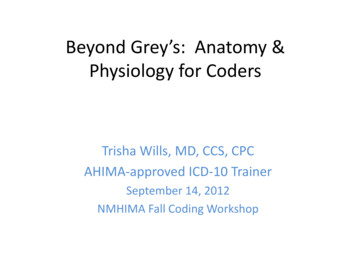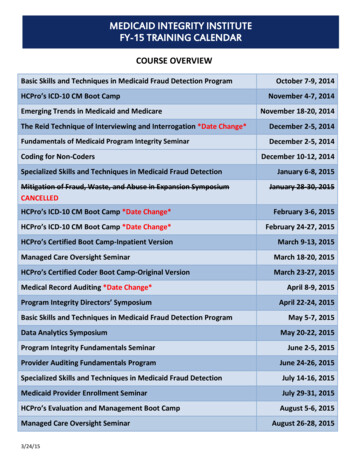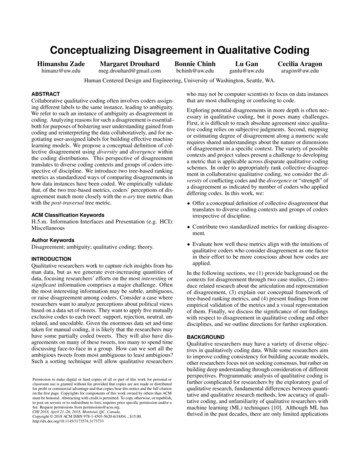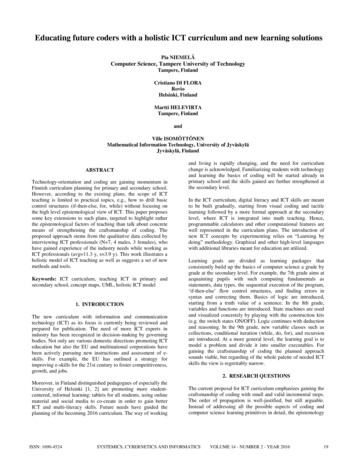
Transcription
Educating future coders with a holistic ICT curriculum and new learning solutionsPia NIEMELÄComputer Science, Tampere University of TechnologyTampere, FinlandCristiano DI FLORARovioHelsinki, FinlandMartti HELEVIRTATampere, FinlandandVille ISOMÖTTÖNENMathematical Information Technology, University of JyväskyläJyväskylä, FinlandABSTRACTTechnology-orientation and coding are gaining momentum inFinnish curriculum planning for primary and secondary school.However, according to the existing plans, the scope of ICTteaching is limited to practical topics, e.g., how to drill basiccontrol structures (if-then-else, for, while) without focusing onthe high level epistemological view of ICT. This paper proposessome key extensions to such plans, targeted to highlight ratherthe epistemological factors of teaching than talk about concretemeans of strengthening the craftsmanship of coding. Theproposed approach stems from the qualitative data collected byinterviewing ICT professionals (N 7, 4 males, 3 females), whohave gained experience of the industry needs while working asICT professionals (avg 11.3 y, s 3.9 y). This work illustrates aholistic model of ICT teaching as well as suggests a set of newmethods and tools.Keywords: ICT curriculum, teaching ICT in primary andsecondary school, concept maps, UML, holistic ICT model1. INTRODUCTIONThe new curriculum with information and communicationtechnology (ICT) as its focus is currently being reviewed andprepared for publication. The need of more ICT experts inindustry has been recognized in decision-making by governingbodies. Not only are various domestic directions promoting ICTeducation but also the EU and multinational corporations havebeen actively pursuing new instructions and assessment of eskills. For example, the EU has outlined a strategy forimproving e-skills for the 21st century to foster competitiveness,growth, and jobs.and living is rapidly changing, and the need for curriculumchange is acknowledged. Familiarizing students with technologyand learning the basics of coding will be started already inprimary school and the skills gained are further strengthened atthe secondary level.In the ICT curriculum, digital literacy and ICT skills are meantto be built gradually, starting from visual coding and tactilelearning followed by a more formal approach at the secondarylevel, where ICT is integrated into math teaching. Hence,programmable calculators and other computational features arewell represented in the curriculum plans. The introduction ofnew ICT concepts by experimenting relies on “Learning bydoing” methodology. Graphical and other high-level languageswith additional libraries meant for education are utilized.Learning goals are divided as learning packages thatconsistently build up the basics of computer science a grade bygrade at the secondary level. For example, the 7th grade aims atacquainting pupils with such computing fundamentals asstatements, data types, the sequential execution of the program,‘if-then-else’ flow control structures, and finding errors insyntax and correcting them. Basics of logic are introduced,starting from a truth value of a sentence. In the 8th grade,variables and functions are introduced. State machines are usedand visualized concretely by playing with the construction kits(e.g. the switch states ON/OFF). Logic continues with deductionand reasoning. In the 9th grade, new variable classes such ascollections, conditional iteration (while, do, for), and recursionare introduced. At a more general level, the learning goal is tomodel a problem and divide it into smaller executables. Forgaining the craftsmanship of coding the planned approachsounds viable, but regarding of the whole palette of needed ICTskills the view is regrettably narrow.2. RESEARCH QUESTIONSMoreover, in Finland distinguished pedagogues of especially theUniversity of Helsinki [1, 2] are promoting more studentcentered, informal learning: tablets for all students, using onlinematerial and social media to co-create in order to gain betterICT and multi-literacy skills. Future needs have guided theplanning of the becoming 2016 curriculum. The way of workingISSN: 1690-4524The current proposal for ICT curriculum emphasizes gaining thecraftsmanship of coding with small and valid incremental steps.The order of propagation is well-justified, but still arguable.Instead of addressing all the possible aspects of coding andcomputer science learning primitives in detail, the epistemologySYSTEMICS, CYBERNETICS AND INFORMATICSVOLUME 14 - NUMBER 2 - YEAR 201619
of the ICT teaching as a whole should be discussed to considerall essential higher level needs. It is important to ensure thatthese findings are sanity checked and that the discussion is notlead by pedagogues only, but validated and augmented by ICTprofessionals, who know the industry needs. The researchquestions to be replied are:1.2.3.Which kind of model would give a more holistic viewof ICT epistemology?How to support the learners in their becoming notonly good coders but also good software architectsand designers?Which kind of learning solutions would support theICT teaching model proposed?3. INDUSTRY NEEDS RULED INTo get a better grasp of the current ICT landscape weinterviewed seven ICT professionals by email, six of whom aresoftware developers and one a program manager. The emailquestionnaire contained the following questions: What are theICT skills needed today/in the future? Which are your best ICTcourses/informal learning experiences? How should ICT betaught in the primary school? With seven replies, we are farfrom scientific significance and based on the data only roughrecommendations can be given. However, the anticipatedholistic model can be verified by referring to the answers. Basedon the replies, we classified ICT related capabilities to fourcategories: the craftsmanship of coding, modeling, user-centereddesign, and project management. More generic skills such ascritical thinking, future working qualifications, and globalcitizenship were also mentioned, however, not taken intoaccount here as they were regarded more as all-encompassing,general capabilities to be taught in other subjects as well.Since the majority of the interviewees represented theimplementation side, the craftsmanship of coding perspectivewas well pronounced. In a list of needed skills, web computingwas mentioned six times, followed by data structure &algorithms (3), testing (2), and mobile coding(1). Among themost common computer languages Java (2), JavaScript (2) andC (1) were listed, but also specialties such as Rust (1),Clojure (1) and Go (1) received votes. High-availabilityengineering (1) and the ability to develop games (1) were seenas useful system level capabilities. Modeling was mentionedfour times: design, UML, architecture, and being able torecognize meaningful entities were listed. User-centered designoccurred once in the form of “understanding the needs of thecustomer and managing them” emphasized by the only projectmanager involved, who considered also project managementand selling as important skills.Our interviewees regarded hands-on experience as the mainbuilding block in learning. They would include in the ICTlessons of primary school e.g. team work and pair-programmingexercises, increase motivation and inspiration by providing goodexamples, combine ICT with sports, and have students buildtheir own e-portfolios. Working in teams or in pairs kids wouldlearn informally scaffolding each other in the zone of proximaldevelopment [3]. Regarding good learning experiences theimportance of teamwork was emphasized (3), especially pairprogramming with friends having a similar level was consideredrewarding.20SYSTEMICS, CYBERNETICS AND INFORMATICSFrom the formal side the basic courses in the beginning werefound the most meaningful (2), and those teaching techniquesthat remain the same regardless of the language such as datastructures and algorithms (3) were valued high. Nevertheless,we also received critical views regarding ICT teaching, forexample: “At high school I never attended any good ICTcourses. But all the math and physics at school helped me tolearn problem solving and how to break down a problem inmultiple pieces.” According to the interviews, the future isdrifting in the direction of HTML5 (2), robots (1), internet ofthings (1), and visualizations (1). These findings were classifiedinto four main categories.The craftsmanship of codingIn the discipline of handicrafts and craftsmanship, learninghappens through doing by hand, which is seen as a way ofleveraging innovation and the creativity. Theories such asintelligent hands [4] and learning by doing, are the basis for thetactile learning language. In maths, the tactile exercises such asfraction pieces and decimal system learning tools are used whileapproaching the symbol language more in-depth. In ICT,bridging the connection between electronics and coding may beachieved with the help of different assembly kits (e.g. LEGOMindStorm and Robots, Arduino, Lilypad, littleBits). Electroniccomponents, such as light emitting diodes, buzzers, and couplerscan be controlled by coding and give a more concrete and clearresponse than visible feedback on a computer screen. As one ofour interviewees puts it, “Learning by doing simply cannot bebeaten in efficiency.”In addition to construction kits, visual programming languagesmay be used as primers. Scratch, for example, providesgraphical support for a user preventing the faulty code or theconnecting of incompatible code sequences. Control structures(such as if-then, for, while) are ready-built, a user only has toadjust parameters, such as counters in iteration loops. Visualprogramming languages are limited in freedom of degrees,which at the initial learning stage will be good to minimize thecognitive load: time is not wasted hunting syntactic errors. Inthe long run, the conciseness of such languages starts to restrictfreedom and creativity indicating the due date to expand to moreexpressive programming languages.Conceptual modeling as a software architectOn the authority of our interviewees, the development of ICTtalent requires strong modeling and conceptualization skills. Thehighlighted modeling skills were designing, mastering UMLmodeling language, being able to separate relevant entities andbuild an architecture of systems. Regarding thinking skillsmentioned ‘logical and critical thinking’ overlap partly with theconceptualizing skills, too. Therefore, we propose conceptualmodeling as one of the key expertises and concept and mindmapping as its preceding preparatory skill. However, havinggood conceptualizing and modeling skills is not useful only inICT, but in deep learning in general, the biggest differencebetween expert and novice thinking being the consistency anddensity of underlying concept schemes. Deeper learning implieslinking atomic details as bigger and more robust constructions.Tying new knowledge to relevant concepts and previouspropositions makes learning more meaningful.VOLUME 14 - NUMBER 2 - YEAR 2016ISSN: 1690-4524
User-centered design to take into account real user needsThe domain of user-centered design was duly emphasized by theonly project manager interviewed (“understanding customer’sneeds and use”, “selling”). A real innovation takes the user’sneeds into account, it focuses on the user and his context andincorporates his perspectives during the whole design processand new applications may be seen as innovations. Future codersneed user-centered design tools to be able to innovate appositeapplications. When the design is to be more user-centered, anessential prerequisite is to know how a customer acts byperceiving the typical work sequence and processes. This can bedone by observing the environment and interviewing users i.e.becoming more aware of user needs.with elementary exercises that combine both the visual codingand tactile learning objectives in order to provide a robusthands-on experience to build the base. When targets graduallygrow more complicated or a bigger team is involved in coding,students will have to learn how to model and easilycommunicate the system structure. To this aim we propose thebuilding block of conceptual modeling. The third threadillustrates the need for user-centered innovations. To be able toinnovate, the student has to make observations in order tobecome acquainted with the customer needs, and to depict theunderlying processes. After that optimizing and improving themis enabled, and ultimately, students come up with new, moreefficient approaches to the problems and challenges.In software projects, when the snapshot of the situation in itsentirety has been obtained and user needs are detected asdetailed manner as possible, the needs are dressed as formal usecases and requirements, which are a starting point to thefollowing implementation. Ultimately, the final projectachievements are checked against the use cases. Whensuccessful, the intended new solution provides added value andmore efficiency by going beyond current practices.Project managementThe golden rule of project management consists of planning,organizing and controlling, efficiency being the ruling principleboth time and money-wise, as our project manager states: - Lineout, what is needed and how to get the most efficient (bothworkload and budget) solution. Less is needed in directimplementation, more having the whole picture with technicalknowledge about possibilities.Project management is also seen as an interface between thecustomer and the team and good communication betweendifferent stakeholders is his responsibility. In addition to takingcare of the good communication within the team it is alsocrucial to involve the customer in the communication loop toensure that the user needs are fulfilled. Often the needs get moredetailed - or even changed - during the process. The current defacto standard in project management is an agile methodologythat embraces self-organizing teams that are capable ofmanaging themselves. More and more, in agile projects peopleare working in remote teams that are self-directed.Agile methodologies target flexibility in taking into account themoving target. A customer may change his mind during theimplementation that is called requirement volatility. Byiteratively ensuring that the direction is right and the productwill better respond to the need, the project management is linkedwith the user-centered design, too. Albeit of the biased sample(only one project manager interviewed) the interview dataconfirmed what was expected i.e. that the project management ismore concerned about the user needs and communication withthe user than developers. Interviews also suggest that the projectmanagement level is more situation aware and concerned aboutretrieving the big picture, whereas developers think more interms of technical solutions.4. THE HOLISTIC ICT TEACHING MODEL AND NEWLEARNING SOLUTIONSThe proposed teaching model is depicted in Figure 1. The mostelementary building block, the craftsmanship of coding, startsISSN: 1690-4524Figure 1: The proposed holistic model for ICT curriculum inprimary and secondary school.Together the threads form the cord of an ICT professional morecapable of handling ICT projects successfully. The entwinedthreads are woven together by project management whichincludes controlling the process (e.g. using agile methods),being able to divide the project in smaller tasks, scheduling andstaying within the deadlines. Next we will examine how thesemissing threads of current ICT curriculum of modelling, usercentered design and project management may be introduced inthe school environment.Various concept map techniques as knowledge building toolsIn computing good software architects are good modelers,whereas in school excellent students are good conceptualizers.In recent years, concept maps have been recognized as aneffective visual learning tool that helps learners memorize andorganize knowledge. Åhlberg [5] recommends maps insituations requiring data parsing and argues that they illustratethe conceptual and propositional structure of written text. Healso considers conversions to both directions, from text to a mapand vice versa, as a good way to work on and elaboratemeanings. In addition to visually appealing and easy to useconcept map applications (bubbl.us, MindMup, CMapTools),the tools of ICT professionals such as the Unified ModellingLanguage (UML) may be introduced to students as a modellingtool that is applicable in ICT teaching in particular.Modeling skills are important for communication purposes, too,both between developers and other stakeholders. Nowadays, asthe development is often geographically distributed,communications skills are extremely necessary. Even if one isnot going to be a developer himself, a better understandingSYSTEMICS, CYBERNETICS AND INFORMATICSVOLUME 14 - NUMBER 2 - YEAR 201621
about the overall structure with a map representation gives aquick generic overview and more means to communicate withdevelopers.oriented students might see this also as a sweet spot of exposingtheir skills for potential employers and polish their CV.Engaged students as self-directed project managersIn education, we also promote the use of concept mapping as anassessment tool. Currently, assessment is based on the student’stest results and activity during lessons. This method is good atmeasuring whether smaller learning objectives have beenreached. However, a more detailed development of conceptualunderstanding and getting a bigger picture is less frequentlyexamined. Meaningful learning results are achieved when aperson consciously and explicitly ties new knowledge torelevant concepts and previous propositions they alreadypossess. Deeper learning implies linking atomic details as biggerand more robust constructions. A concept map can beunderstood as a visualization of a mental concept construction.Authentic tasks facilitating user-centered designOften real world problems are open ended, complex, requireextended knowledge and emergent solutions. According to theEngagement Learning Theory by Kearsley and Shneiderman [6],a valid way of getting students committed is to providemeaningful, creative, and authentic tasks, which reflect theinterests of students themselves, as much as possible. Finding anachievable yet interesting project target can prove to be thehardest part of the whole project, but once the goal is set, thegroup may start working backward from it [7], e.g. planning,sharing the goal into smaller executables, scheduling these parts,and finally moving to implementation.User-centered design implies the participatory methods ofinquiry of real - not self-determined - customer needs, modelingthe situation, and means of improving current practices. Foryounger students, gaining the required level of situationawareness is a meta-cognitively demanding task and requiressuch future working skills as communication and collaboration.In software projects, when the snapshot of the situation has beenobtained, the demands are dressed as formal use cases or lighteruser stories and requirements, which are a starting point to thefollowing implementation.The authenticity of the project is increased with a real customer,who is interested in getting the thing done, is waiting for the endproduct and giving feedback. A real and useful innovation takesuser’s needs into account; it focuses on the user and his contextand incorporates his perspectives during the whole designprocess, hence providing an opportunity of producing whatScardamalia et al. [7] call emergent outcomes, i.e. through newconsiderations, creativity and sustained work something brilliantmight emerge. However, the emphasis here is not on theoutcome but rather to familiarize with project work practices,learn how to co-operate, communicate, and take responsibility.Nousiainen [8] emphasizes that the continuous involvement ofusers is a goal as such but also a way to empower users andpromote workplace democracy and the means to practice theworking life skills of participation, collaboration, andcommunication. In some schools, students have already startedto innovate e.g. new means to recycle [9]. If no customers areavailable, suitable activities such as school projects could be e.g.doing your own online textbook or encyclopedia or pilot tests ofinnovative new technologies and rating them. Often thepublicity of putting the end result on the web provides asufficient incentive for the students to do their best. Strategically22SYSTEMICS, CYBERNETICS AND INFORMATICSSeveral educators agree along with industry representatives thatthere is a gap between current education and future work skills.Moylan [10] identifies “Project Learning" as a key methodologyfor closing this gap between current curriculum and developingtheir necessary knowledge and skills essential for success in the21st century. Among other forces, President Obama alsoinstructs schools to transfer from trivial bubble filling exercisesto such 21st century skills like problem-solving, critical thinking,entrepreneurship and creativity: the school has to train childrenfor future challenges and work [11].Project management may be practiced by open assignments i.e.with school projects that have to be scheduled and delivered in atimely fashion. In such projects, students should be responsiblefor the acquisition of information needed, for example, byinterviewing their intended customer or searching data from thenet. It would be good to attempt to raise the abstraction level bymodeling. For schools to adopt agile project working style,students would come together to work on an ICT project thatthey have selected by themselves, plan and share the work, takeon roles that play to their strengths and interests and thenimplement and solve problems together till the project is done.Being ultimately learner-centered this type of learningassignment requires a very different approach of the teachercompared to traditional classroom instructions. The teacher is nolonger the lecturer and the decider, but rather a facilitator orcoach learning alongside students; sometimes to give up thecontrol may feel like a farmer that is selling his farm. However,the effectiveness of instructor-led lessons and lecturing has longbeen questioned and as a subject ICT is one of the best suitedfor applying project oriented learning style. However, we notethat often transferring to an open-ended working mode requiressome practicing and external pressure to get things done,whether the agent generating the pressure is a teacher orpreferably an external customer.5. CONCLUSIONSFinland is planning to enrich its primary and secondary schoolcurriculum with coding in order to prepare students for thefuture working life. Instead of settling on only the basics ofcoding, e.g. code flow and control structures, we claim that theability to innovate and design software systems is at the veryheart of software engineering. By adding the key areas ofmodeling and user-centered design to instruction schemes, wecreate a more holistic ICT curriculum. The conception andmodeling ability is needed not only in ICT but in knowledgebuilding and conceptual thinking in general. User-centereddesign improving the practices of one’s own environment mayalso be seen as a tool of empowerment. An empowered memberof the society, who is aware of user needs, will also becomemore innovative.Hands-on experimentation was also considered beneficialamong our interviewees: games, pair-programming, andlearning from others informally were seen as ways to fosterlearning and engagement. Innovativeness and creativity arebuzzwords used in curriculum planning, often in accordancewith arts and crafts, which are assumed to enhance them. WithVOLUME 14 - NUMBER 2 - YEAR 2016ISSN: 1690-4524
new methods and learning solutions, creativity may be fosteredwith STEM subjects as well: building robots, makinganimations, and playing and even developing games (e.g. AngryBirds Space to assimilate gravity basics) are new, engaging andmotivating ways of learning.Since many students are passionate about playing, games as newlearning solutions have proven to be very powerful. Highmotivation and engagement appear as a “flow” while playing.Fu et al. [12] examined engaging games and listed propertiessuch as immersion, the clarity of the goal, autonomy, feedback,challenge, and social interaction as the ingredients of flow.Moreover, it has been reported that games can have a positiveimpact on pupils’ perceptual templates, knowledge acquisitionand affective outcomes [13]. By including the suitable featuresof games in learning environments, serious education maytransform to edutainment. The level of shared fun increasesinterest in ICT in general and ICT learning objects may begamified, too.Coding starts in Finnish schools in the autumn of 2016. ICTclasses become a laboratory of new learning tools andmethodology. By documenting experiments and applyingcontinuous development cycles, we may iteratively improve thelearning results. In addition to teaching to code, it is necessaryto introduce new tools for modeling and user-centered design.6. REFERENCES[1] K. Hakkarainen, L. Hietajärvi, K. Alho, K. Lonka, K.Salmela-Aro, "A Paradigmatic Analysis of ContemporarySchools of IS Development", International Encyclopedia ofthe Social & Behavioral Sciences, pp. 918-923. 2015.[2] L. Krokfors, "Learning. Creatively. Together", EducationalChange Report 2016. 2015.[3] L.Vygotsky, "Interaction between learning anddevelopment", Readings on the development of children, 23.3:pp. 34-41. 1978.[4] L. Hyde, Making it , New York Times, 6. 2008[5] M. Åhlberg, Concept maps as a research method. 2002.[6] G. Kearsley and B. Shneiderman, Engagement Theory: AFramework for Technology-Based Teaching and Learning.1999.[7] M. Scardamalia, J. Bransford, B. Kozma and E. Quellmalz,"New assessments and environments for knowledge building,"in Assessment and Teaching of 21st Century Skills. Springer,pp. 231-300. 2012.[8] T. Nousiainen, Children's involvement in the design ofgame-based learning environments. 2009.[9] M. Aineslahti, A Journey in the Landscape of SustainableSchool Development. 2009.[10] W. A. Moylan, "Learning by Project: Developing Essential21st Century Skills Using Student Team Projects",International Journal of Learning, vol. 15. 2008.[11] B. Trilling and C. Fadel, 21st Century Skills: Learningfor Life in our Times. John Wiley & Sons. 2009.[12] F. Fu, R. Su and S. Yu, "EGameFlow: A scale to measurelearners' enjoyment of e-learning games", Computers &Education, vol. 52, pp. 101-112. 2009.[13] T. Connolly, E. Boyle, E. MacArthur, T. Hainey, & J.Boyle, "A systematic literature review of empirical evidence oncomputer games and serious games", Computers & Education,59(2), 661-686. 2012.ISSN: 1690-4524SYSTEMICS, CYBERNETICS AND INFORMATICSVOLUME 14 - NUMBER 2 - YEAR 201623
The proposed approach stems from the qualitative data collected by interviewing ICT professionals (N 7, 4 males, 3 females), who have gained experience of the industry needs while working as ICT professionals (avg 11.3 y, s 3.9 y). This work illustrates a holistic model of ICT teach ing as well as suggests a set of new methods and tools.

